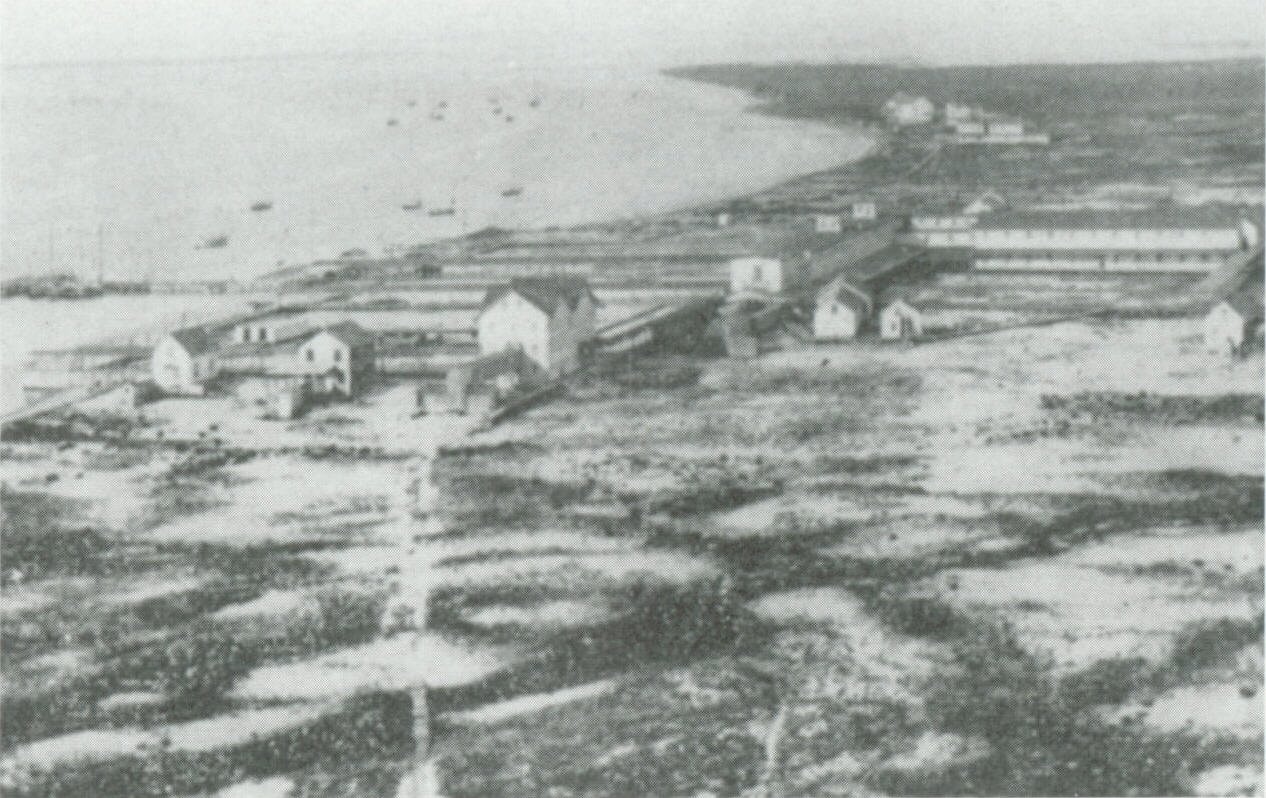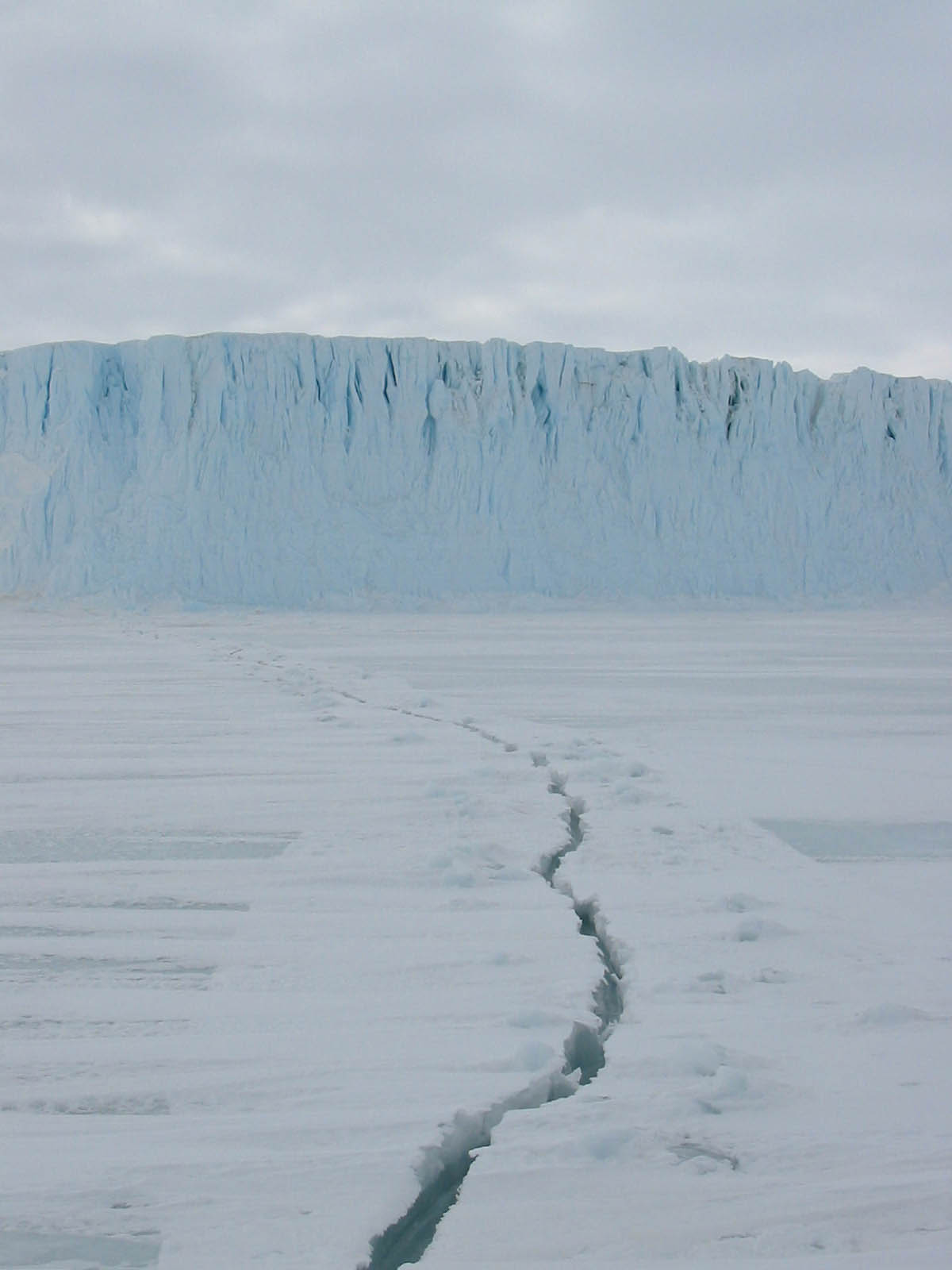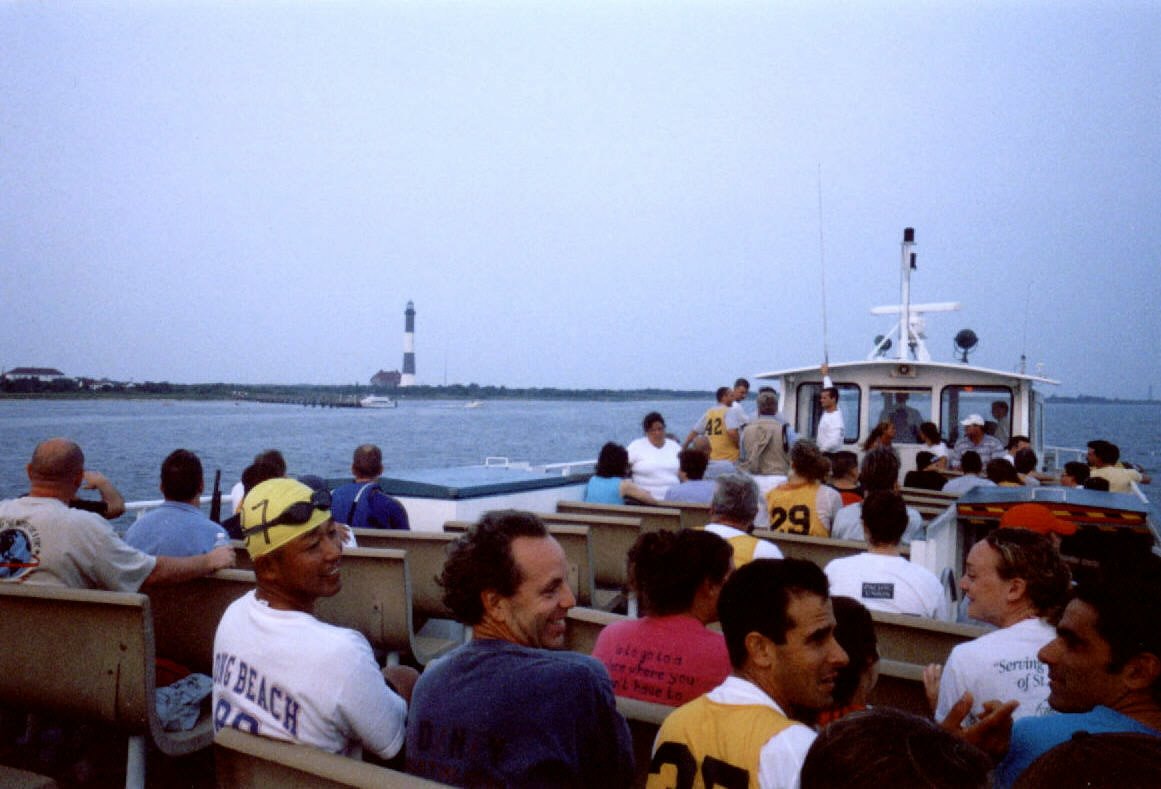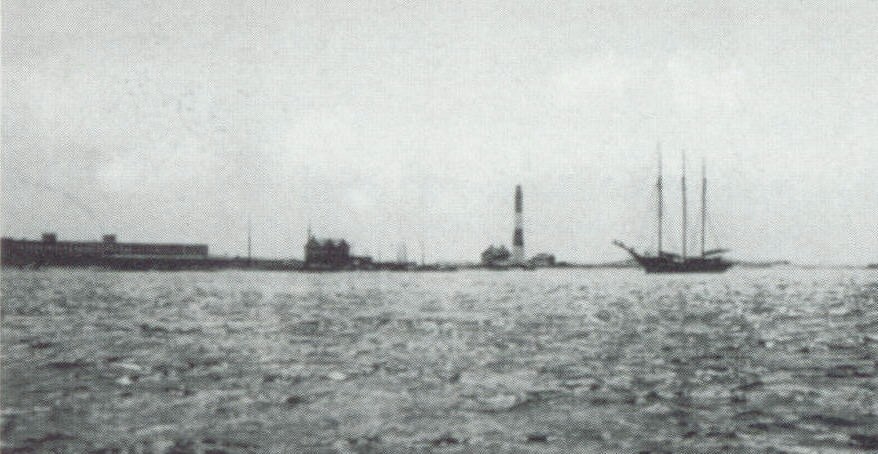Friday, March 27, 2009
More History Coming...
Hello all, Just a quick update on the swim history research. Newspaper articles from every year except 1959 and 1963 have been found. Many alumni swimmers have also sent photos in for the project. I think we are nearing the end of the research phase at this point. I will try to post some content for you all to see soon. The artwork to the right was done by my mother for the cover to our book, way to go mom! It is growing into quite a project. Stay tuned!
Wednesday, April 9, 2008
Part 3 - The Surf Hotel
 While it is hard to miss the landmark Fire Island Lighthouse as the ferry arrives across the Great South Bay for the start of the Cross Bay Swim, there was another significant historical landmark located at this site that was not as lucky. It was the mid 1800s and a hotel owner from New York City named David S. S. Sammis, who had acquired the lease to 120 acres of property between the Fire Island Lighthouse and what is today Saltaire, was looking to take advantage of the expanding railroad on Long Island to build a summer resort by the beach. Other resorts in Saratoga Springs New York and Far Rockaway had attracted much attention and Mr. Sammis was ambitious enough to build a resort in this place that was well off the beaten path at that time in Long Island History. In 1855 a chowder house was constructed on the beach to the east of the Fire Island Lighthouse and met with enough success to convince Mr. Sammis to expand for the 1856 season. A 100 foot structure was constructed and the Surf Hotel was born. In order to reach the Surf Hotel travelers needed to travel to Deer Park by rail or carriage and be transported to the Babylon Dock on the Great South Bay. Transport to the Surf Hotel was by chartered ferry to the location of the current dock we arrive at today for the Cross Bay Swim. It is incredible to imagine that this quiet location was once an active ferry terminal transferring visitors to and from a popular seaside resort. What might be considered a day at the beach to many now was a journey that warranted a stay of a week or more at the Surf Hotel. Mr. Sammis’s resort got off to a strong start in 1856 but that was soon followed by difficult financial times and the Civil War which slowed business and almost put an end to the Surf. Mr. Sammis persevered through this period which included a bankruptcy petition as well as a period of time where the hotel was closed while the Civil War was raging in America. As the Surf struggled to survive a new lighthouse was being constructed just to the West to replace the existing smaller beacon The new lighthouse was activated as an aid to navigation on November 1, 1858.
While it is hard to miss the landmark Fire Island Lighthouse as the ferry arrives across the Great South Bay for the start of the Cross Bay Swim, there was another significant historical landmark located at this site that was not as lucky. It was the mid 1800s and a hotel owner from New York City named David S. S. Sammis, who had acquired the lease to 120 acres of property between the Fire Island Lighthouse and what is today Saltaire, was looking to take advantage of the expanding railroad on Long Island to build a summer resort by the beach. Other resorts in Saratoga Springs New York and Far Rockaway had attracted much attention and Mr. Sammis was ambitious enough to build a resort in this place that was well off the beaten path at that time in Long Island History. In 1855 a chowder house was constructed on the beach to the east of the Fire Island Lighthouse and met with enough success to convince Mr. Sammis to expand for the 1856 season. A 100 foot structure was constructed and the Surf Hotel was born. In order to reach the Surf Hotel travelers needed to travel to Deer Park by rail or carriage and be transported to the Babylon Dock on the Great South Bay. Transport to the Surf Hotel was by chartered ferry to the location of the current dock we arrive at today for the Cross Bay Swim. It is incredible to imagine that this quiet location was once an active ferry terminal transferring visitors to and from a popular seaside resort. What might be considered a day at the beach to many now was a journey that warranted a stay of a week or more at the Surf Hotel. Mr. Sammis’s resort got off to a strong start in 1856 but that was soon followed by difficult financial times and the Civil War which slowed business and almost put an end to the Surf. Mr. Sammis persevered through this period which included a bankruptcy petition as well as a period of time where the hotel was closed while the Civil War was raging in America. As the Surf struggled to survive a new lighthouse was being constructed just to the West to replace the existing smaller beacon The new lighthouse was activated as an aid to navigation on November 1, 1858.The period following the Civil War until 1892 was the golden era for the Surf Hotel which was made much more accessible due to the railroad expansion to Babylon. Visitors to the resort enjoyed bathing in both the ocean waters as well as the more docile waters of the Great South Bay.
 Guests also took advantage of the close location to the Fire Island Inlet and went on fishing excursions into the Atlantic Ocean on catboats to catch the plentiful bluefish. The resort also provided many other activities such as tennis, bowling and billiards.
Guests also took advantage of the close location to the Fire Island Inlet and went on fishing excursions into the Atlantic Ocean on catboats to catch the plentiful bluefish. The resort also provided many other activities such as tennis, bowling and billiards. By 1892 the Surf Hotel had started to decline and David S. S. Sammis, who was 74 years old, was looking to sell. It is late August, 1892 and a raging cholera epidemic in Europe threatens to infect American shores through stricken steerage passengers emigrating from Hamburg, Germany. Incoming ocean liners are quarantined and steerage passengers are offloaded to quarantine hospitals on Hoffman and Swinburne Islands in Lower New York Bay. When all else fails, the dead are transferred to the Swinburne crematory. Most of the more affluent travelers in first and second-class cabins are not infected, but under the quarantine they are not allowed into the country for 20 days. When so-called Asian cholera -- an acute infectious disease spread by contaminated food and water -- quickly breaks out among stokers tending the steam boilers, however, panic sets in. Cabin passengers want off the ship. What to do with them during the duration of their quarantine? State health authorities have an idea. Out on the southern coast of Long Island is a sandy, virtually uninhabited barrier beach called Fire Island, where dwell only shorebirds, deer, ticks, occasional day trippers and the master of the Fire Island Lighthouse. But at Democrat Point, at the western end of the island, there is a rundown old hotel called the Surf, which, in better days, played host to revelers and sun worshippers from far and wide. Why not buy the hotel and its surrounding 120 acres of sand, ship the quarantined passengers out to the Surf Hotel and let them live out their short captivity in ease and isolation? Democratic Governor Roswell P. Flower loves the idea and orders it done. He even ponies up $50,000 of his own money as a down payment to get things moving. Not in our neighborhood, cry Babylon and Islip Town residents. And baymen, claiming their livelihood is threatened, scream bloody murder. Fire Island is on the verge of becoming a battleground. The State of New York won out and purchased the property to carry out the quarantine which was done peacefully.
Following this incident the State attempted to reopen the Surf but its time had passed. By 1908 the storm damage property was dismantled and turned into the first State Park in New York. The Fire Island Parks Commission (Later the Long Island Parks Commission headed by Robert Moses) was created to administer the property as a park to be enjoyed by the public. It is now part of Robert Moses State Park although the land to the East of the lighthouse is not accessible to the public.
As you pull up to the dock at the next Cross Bay swim take a look up to your left and think of the great Surf Hotel, the events that occurred there many years ago and the echoes that resonate through to today.
If you would like to learn more about the Surf Hotel you may want to consider purchasing the book “Fire Island’s Surf Hotel and other Hostelries on Fire Island Beaches in the Nineteenth Century” by Harry W. Havemeyer
Tuesday, March 25, 2008
Part 2 - The Fire Island Lighthouse
 The Fire Island Light was an important landmark for transatlantic ships coming into New York Harbor at the turn of the 19th century. For many European immigrants, the Fire Island Light was their first sight of land upon arrival in America. The lighthouse has served as the starting point for the Cross Bay Swim back as far as 1927 and has played a key role in the uniqueness and grandeur of this amazing event.
The Fire Island Light was an important landmark for transatlantic ships coming into New York Harbor at the turn of the 19th century. For many European immigrants, the Fire Island Light was their first sight of land upon arrival in America. The lighthouse has served as the starting point for the Cross Bay Swim back as far as 1927 and has played a key role in the uniqueness and grandeur of this amazing event.The first lighthouse built on Fire Island was completed in 1826. It was a 74-foot high, cream colored, octagonal pyramid made of Connecticut River blue split stone. The tower was built at the end of the island, adjacent to the inlet. As late as 1856, a boatman sailing through the Inlet could toss a newspaper to the lighthouse keeper. This tower was not effective due to its lack of height. It was taken down and the stone was reused to build the terrace for the present lighthouse. Today a circular ring of bricks and stone are all that remain of the original lighthouse. Due to the westward migration of sand along the beach, known as littoral drift, the inlet is now approximately six miles westward of this site.
In 1857 Congress appropriated $40,000 for the construction of a new tower, 168 feet tall. It was lit for the first time on November 1, 1858. This tower was made of red brick, painted a creamy yellow color. The tower was changed to the present day-mark of alternating black and white bands in August 1891. The new tower was fitted with a First Order Fresnel Lens, which emitted a white flash at one minute intervals. A Funk Lamp with 4 concentric wicks was used for illumination. Over the years various fuels were used for the lamps, including whale oil, lard oil, mineral oil and kerosene. Electricity finally reached the lighthouse on September 20, 1938. However, on September 21, 1938 a hurricane struck the island, effectively severing all electric power to the island and causing a delay in the electrification of the Fire Island Light Station. The United States Coast Guard has been present on Fire Island since its inception in 1915. A Coast Guard Station was established on the Lighthouse tract. Eventually the United States Lighthouse Service was dissolved. The administration of lighthouses was placed under the jurisdiction of the US Coast Guard in 1939 "in the interest of economy and efficiency".
The Fire Island Lighthouse was decommissioned as an aid to navigation on December 31, 1973. The new aid to navigation was a "small flash tube optic" installed atop the Robert Moses State Park Water Tower. After the Fire Island Lighthouse was decommissioned in 1974, the Coast Guard gave the National Park Service a five-year permit to use the entire Lighthouse Tract. In 1979, the tract was declared by law to be within the boundaries of the Fire Island National Seashore. With limited funds, the major function of the Park Service during its early administration of the Lighthouse tract was to prevent further deterioration of the buildings through neglect and vandalism. Between 1974 and 1980, private citizens grouped together in an effort to "save the Fire Island Lighthouse." The strobe light on the Robert Moses Tower only shone seaward and was of no use to boaters on the Great South Bay. Public support for restoration of the Fire Island Lighthouse was great among the Baymen.
In 1982, the Fire Island Lighthouse Preservation Society was formed. They successfully raised over 1.3 million dollars for the restoration and preservation of the Fire Island Lighthouse. In 1984, the Fire Island Lighthouse was placed on the National Register of Historic Places.
The Lighthouse was restored to its 1939 condition, which is when electricity was first installed. On Memorial Day, May 28, 1986, the Fire Island Lighthouse was relit and reinstated as an official aid to navigation.
In December 1996 the Fire Island Lighthouse Preservation Society (FILPS) through an agreement with the National Park Service took over the maintenance and operation of the Fire Island Lighthouse and Keeper's Quarters'
Today the light is lit by two 1000-watt bulbs, which rotate in a counter-clockwise direction, giving the appearance of a flash every 7.5 seconds. The light is visible for approximately 21-24 miles. Fully automated operation and maintenance of the light itself, remains under the jurisdiction of the United States Coast Guard.
It is hard to imagine the Cross Bay Swim today without the Fire Island Lighthouse. Had it not been saved in the early 1980's the Cross Bay Swim itself may have been doomed to the history books. Luckily the efforts of the Fire Island Lighthouse Preservation Society to save the light were successful as were the efforts to revive the Cross Bay Swim in 1999. The success of the individuals involved in both these selfless tasks have done a huge service to the community and all who visit the lighthouse and participate in the swim. It is highly recommended that you climb the lighthouse as there is no better view on the whole of the Great South Bay than from the top of the light. It not only provides the most amazing view of the swim course but an opportunity to reflect on the storied history of the Lighthouse and the Cross Bay Swim.
(This post has taken significant excerpts for the Fire Island Lighthouse website)
Wednesday, March 19, 2008
Part 1 - In the beginning

It seems fitting that our swim history should begin where else but at the very beginning with the birth of Long Island, Fire Island and the Great South Bay. Long Island has actually only existed for a mere blink of an eye in geological terms. It took thousands of years to create and numerous natural events occurred to form the shape of Long Island, its terrain, and its environment. The top layer of Long Island we know today was made by large glaciers which existed between 60,000 and 21,000 years ago. See picture to left for what Long Island and the Great South Bay may have looked like when glaciers covered the northeast.
The first glacier, which occurred 60,000 years ago, was the Wisconsian Glacier which moved south across Canada and Northern America. It carried boulders, rocks, gravel, and soil in a frozen wall of ice hundreds of feet high which were deposited in mounds of hills stretching from Brooklyn to Montauk. About 40,000 years later the glacier advanced to almost the same position. When it began to melt, another moraine was deposited. This ridge runs from Brooklyn Heights to Orient Point.
The way in which Long Island was formed resulted in two different terrains. The North Shore contains many bays, harbors, especially in the western section. On the other hand, the South Shore was a flat outwash plain, which is now made of mainly sand and gravel and gradually slopes to the sea. From Rockaway to Montauk Point is seventy five miles of sandbars and beaches with several inlets. The difference in the island's geography was a result of only the North Shore being covered with ice.
The sediments that were deposited off the south shore of Long Island were gradually formed into what is today Fire Island by the ocean currents and created the Great South Bay. The Great South Bay is technically not a bay but is a lagoon approximately 45 miles long forming a large natural harbor. It is protected by Fire Island, a barrier island approximately 30 miles long, as well as the eastern end of Jones Beach Island. Around 1683 Fire Island Inlet broke through separating Fire Island from Jones Beach Island. The Fire Island Inlet was to grow to nine miles in width before receding and overtaking Jones Beach Island in the late 1800s to form the overlapping inlet we have today.
Friday, February 22, 2008
Cross Bay Swim History
The Cross Bay Swim has a rich history that dates back to the early 1900s. Explore some of the articles and personal accounts of this Long Island treasure! We will be adding to this site as research moves forward including historical newspaper articles and personal accounts. If you have any information pertaining to the history of the swim such as articles, pictures or other interesting facts, please email Rob Roos at rroos31@nycap.rr.com.
Subscribe to:
Posts (Atom)

